|
 Marasmius croceus Marasmius croceus
BiostatusPresent in region - Indigenous. Non endemic
Images (click to enlarge) | 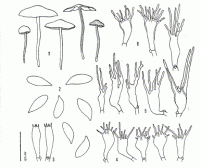
Caption: Fig. 15 (1-6). Marasmius croceus G. Stevenson (ZT 68-116).- 1. Basidiomes.- 2. Basidiospores.-
3. Basidia.- 4. Cheilocystidia. 5. Caulocystidia.- 6. Pileipellis (x1000). | 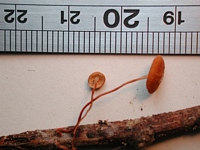
Caption: fruitbody
Owner: J.A. Cooper | 
Caption: scale=5mm
Owner: J.A. Cooper | 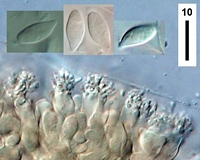
Caption: spores and cheilocystidia
Owner: J.A. Cooper | 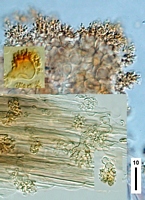
Caption: upper siccus broom cells on cap. Lower caulocystidia.
Owner: J.A. Cooper | 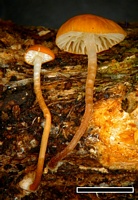
Caption: scale=5mm
Owner: J.A. Cooper | 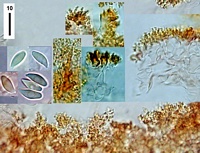
Caption: spores and cap surface cells.
Owner: J.A. Cooper | 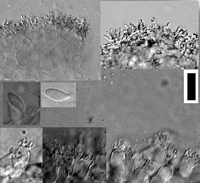
Caption: scale = 10um. Upper siccus broom cells on cap, spores, lower cheilocystidia.
Owner: J.A. Cooper | 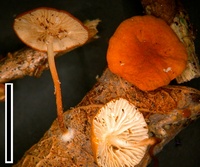
Caption: scale=5mm
Owner: J.A. Cooper | 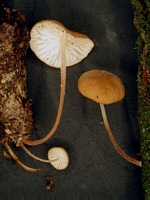
Owner: J.A. Cooper | 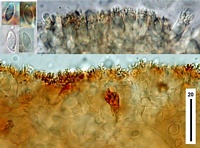
Caption: upper: cheilocystidia and spores. Lower: cap surface
Owner: J.A. Cooper | 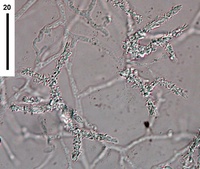
Caption: hyphae in culture.
Owner: J.A. Cooper | 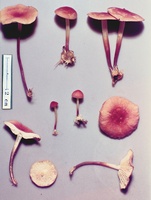
Owner: E. Horak: © Creative Commons Attribution-Noncommercial 3.0 New Zealand | 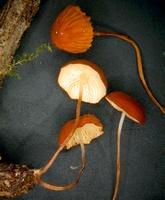
Owner: J.A. Cooper | 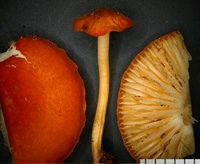
Owner: J.A. Cooper | |
Article: Stevenson, G. (1964). The Agaricales of New Zealand: V. Kew Bulletin 19(1): 1-59.
Description: Pileus 1-2 cm diam., bright saffron, velvety, plano-convex with down rolled margin; flesh thin, whitish. Gills adnexed to adnate, moderately close, whitish. Stipe 1.5-2.5 cm x 1-2 mm, cream above, orange below, velvety, tough, solid, sometimes tapering at base. Spores 8-10 x 3-4 µm non-amyloid, thin-walled; gill edge with many cystidia like broom-cells or small awl-shaped cells, 10 x 1-2 µm. Cuticle of pseudo-amyloid broom-cells and awl-shaped cells, 10 x 1-3 µm.
Habitat: In Nothofagus litter, Butterfly, Wellington, 22.5.1959, Stevenson (type).
Article: Desjardin, D.E.; Horak, E. (1997). Marasmius and Gloiocephala in the South Pacific Region: Papua New Guinea, New Caledonia, and New Zealand taxa. Bibliotheca Mycologica 168: 152 p.
Description: Pileus 8-30 mm diam, hemispherical with incurved margin when young, expanding with age to
convex, broadly convex or plano-convex, with or without ; a broadly obtuse umbo, non-striate;
surface dull, dry, minutely velutinous; orangish brown overall when young, fading towards the
margin in age. Context membranaceous, thin, white to pale orange.- Lamellae adnate to
subemarginate, close (23-28) with 2-3 series of lamellulae, often anastomosing, moderately broad
(1-2 mm), white at first changing to cream with age; edges even, concolorous.- Stipe 20-45 x 1-2
mm, central, terete, equal or gradually tapering towards the base, dull, dry, tough, fistulose,
minutely pruinose (at least in upper portion), non-insititious, base attached to substrate with white
or yellowish mycelial strands; cream to orange or orangish brown at the apex, grading to fuscous
below; context brown at the base.- Odor and taste not distinctive.
Basidiospores (7.0)7.5-9.0 x 3.0-3.5(-4.0) µm, narrowly ellipsoid, sometimes curved in profile,
smooth, thin-walled, hyaline, inamyloid. - Basidia 20-24 x 5-6 µm, cylindrical to subclavate, 4-spored, clamped.- Cheilocystidia common, of Siccus-type cells; main body 10-20 x 5-9 µm ,
polymorphic, subclavate to broadly clavate or irregular in outline, hyaline to yellowish, thin-walled;
apical setulae 2-12 x 0.5-1.0 µm, cylindrical, hyaline.- Pleurocystidia absent.- Pileipellis
hymeniform, not mottled, composed of Siccus-type cells; main body 14-25 x 5-10 µm, cylindrical to
clavate, yellowish brown, base thin-walled, apex moderately thick-walled (up to 0.5 mm); apical
setulae 3-20 x 1 µm , cylindrical to needle-like, thick-walled to solid, yellowish brown.- Pileal and
lamellar trama dextrinoid. - Stipe tissue monomitic; cortical hyphae cylindrical, orangish brown,
dextrinoid.- Caulocystidia common, of Siccus-type cells; main body 10-20 x 4-8 µm , polymorphic,
hyaline to pale yellow, thin-walled to moderately thick-walled, with few to numerous apical setulae
5-30 x 1-2 µm, narrowly conical to needle-like.- Clamp connections present.
Habitat: Habit, habitat and distribution.-Solitary, in groups on Nothofagus litter (holotype), or on leaf litter
in forests dominated by Dacrydium, Quintinia and Weinmannia (Nothofagus absent). Australia,
New Zealand.
Notes: Marasmius croceus is characterized by a smooth, orangish brown to bright saffron pileus, close,
broad, non-marginate lamellae, a pruinose, orangish brown stipe, relatively small basidiospores, no
pleurocystidia, and Siccus-type pileipellis cells and caulocystidia with long setulae. The species
belongs in sect. Sicci series Leonini, where it is allied with M. leoninus Berk., M. abundans var.
abundans Corner and M. sullivantii Mont. Marasmius leoninus, from South America, differs in
forming a sulcate to deeply furrowed pileus, subdistant lamellae (12-16), a mottled pileipellis with
numerous unpigmented cells, and more reduced caulocystidia (Holotype, K!). Marasmius
abundans, from Malaya, differs in forming a sulcate-striate pileus, fewer lamellae (14-22), a
glabrous stipe lacking caulocystidia, and larger basidiospores measuring 10-13 x 3-4 µm (fide
Corner, 1996). Marasmius sullivantii from eastern North America, differs in forming a deep
reddish brown to orangish red pileus, numerous fusoid pleurocystidia, cheilocystidia and pileipellis
cells with shorter setulae (2.5-8.0 µm), and two types of caulocystidia (Holotype, PC!). Marasmius
croceus is also similar to the Australian species Marasmius elegans (Cleland) Desjardin & E.
Horak, comb. nov. [Basionym: Collybia elegans Cleland, Trans. Royal Soc. S. Australia 57: 187.
1933. Holotype: Mt. Lofty, AD #3788]. The latter species differs, however, in forming larger
basidiospores (10.5-13.0 x 4.5-6.0 µm), pileipellis cells with shorter setulae (2-8 µm long), and
irregularly cylindrical, thick-walled caulocystidia instead of Siccus-type caulocystidia (Holotype,
AD!).
|